
- Subject:
- Psychology
- Social Science
- Material Type:
- Unit of Study
- Provider:
- Rice University
- Provider Set:
- OpenStax College


By the end of this section, you will be able to:Explain the brain functions involved in memoryRecognize the roles of the hippocampus, amygdala, and cerebellum

This textbook provides standard introduction to psychology course content with a specific emphasis on biological aspects of psychology. This includes more content related to neuroscience methods, the brain and the nervous system. This book can be modified: feel free to add or remove modules to better suit your specific needs.Please note that the publisher requires you to login to access and download the textbooks.
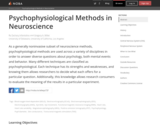
As a generally noninvasive subset of neuroscience methods, psychophysiological methods are used across a variety of disciplines in order to answer diverse questions about psychology, both mental events and behavior. Many different techniques are classified as psychophysiological. Each technique has its strengths and weaknesses, and knowing them allows researchers to decide what each offers for a particular question. Additionally, this knowledge allows research consumers to evaluate the meaning of the results in a particular experiment.

Students observe and test their reflexes, including the (involuntary) pupillary response and (voluntary) reaction times using their dominant and non-dominant hands, as a way to further explore how reflexes occur in humans. They gain insights into how our bodies react to stimuli, and how some reactions and body movements are controlled automatically, without conscious thought. Using information from the associated lesson about how robots react to situations, including the stimulus-to-response framework, students see how engineers use human reflexes as examples for controls for robots.

This resource is a video abstract of a research paper created by Research Square on behalf of its authors. It provides a synopsis that's easy to understand, and can be used to introduce the topics it covers to students, researchers, and the general public. The video's transcript is also provided in full, with a portion provided below for preview:
"Quantum materials are opening up a realm of possibilities in materials research. Among the best known examples are superconductivity and quantum computing. But that’s only the beginning. The same properties that make these materials unique are also enabling researchers to demystify the inner workings of the human brain. So what makes quantum materials well suited for this purpose? Unlike the free-flowing electrons in ordinary conductors or semiconductors, electrons in quantum materials show correlated behavior. That in itself has been the focus of intense physics research. But the upshot for brain research is tunable electronic behavior that can mimic the electronic signaling of neurons and the synapses between them. Most importantly, quantum materials can simulate synaptic plasticity. Plasticity is the biological ability that makes learning and memory formation possible. It’s all about timing. Connections between neurons that fire within a short, milliseconds-long time window grow stronger..."
The rest of the transcript, along with a link to the research itself, is available on the resource itself.

Replicability of findings is at the heart of any empirical science. The aim of this article is to move the current replicability debate in psychology towards concrete recommendations for improvement. We focus on research practices but also offer guidelines for reviewers, editors, journal management, teachers, granting institutions, and university promotion committees, highlighting some of the emerging and existing practical solutions that can facilitate implementation of these recommendations. The challenges for improving replicability in psychological science are systemic. Improvement can occur only if changes are made at many levels of practice, evaluation, and reward.

In A Plaguing Problem, students need to reconstruct lost knowledge about pain relieving drugs. They learn about concepts such as neurotransmission, the neurobiology and history underlying drug addiction, pain management, and analgesia. This game consists of three consecutive episodes with a continuous storyline and we recommend playing the episodes in order.

In Nothing To Rave About, students are asked to uncover why there has been a dramatic increase in the number of teens admitted to the emergency room after partying at a local dance club. During their investigation, they learn how ecstasy and other club drugs act on the nervous system. This game consists of three consecutive episodes with a continuous storyline and we recommend playing the episodes in order.

Students learn about human reflexes, how our bodies react to stimuli and how some body reactions and movements are controlled automatically, without thinking consciously about the movement or responses. In the associated activity, students explore how reflexes work in the human body by observing an involuntary human reflex and testing their own reaction times using dominant and non-dominant hands. Once students understand the stimulus-to-response framework components as a way to describe human reflexes and reactions in certain situations, they connect this knowledge to how robots can be programmed to conduct similar reactions.
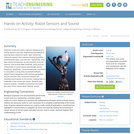
Students continue to build a rigorous background in human sensors and their engineering equivalents by learning about electronic touch, light, sound and ultrasonic sensors that measure physical quantities somewhat like eyes, ears and skin. Specifically, they learn about microphones as one example of sound sensors, how sounds differ (intensity, pitch) and the components of sound waves (wavelength, period, frequency, amplitude). Using microphones connected to computers running (free) Audacity® software, student teams experiment with machine-generated sounds and their own voices and observe the resulting sound waves on the screen, helping them to understand that sounds are waves. Students take pre/post quizzes, complete a worksheet and watch two short online videos about "seeing" sound.
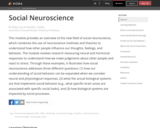
This module provides an overview of the new field of social neuroscience, which combines the use of neuroscience methods and theories to understand how other people influence our thoughts, feelings, and behavior. The module reviews research measuring neural and hormonal responses to understand how we make judgments about other people and react to stress. Through these examples, it illustrates how social neuroscience addresses three different questions: (1) how our understanding of social behavior can be expanded when we consider neural and physiological responses, (2) what the actual biological systems are that implement social behavior (e.g., what specific brain areas are associated with specific social tasks), and (3) how biological systems are impacted by social processes.

Why do humans have two ears? How do the properties of sound help with directional hearing? Students learn about directional hearing and how our brains determine the direction of sounds by the difference in time between arrival of sound waves at our right and left ears. Student pairs use experimental set-ups that include the headset portions of stethoscopes to investigate directional hearing by testing each other's ability to identify the direction from which sounds originate.

Provides students with the basic tools for analyzing experimental data, properly interpreting statistical reports in the literature, and reasoning under uncertain situations. Topics organized around three key theories: Probability, statistical, and the linear model. Probability theory covers axioms of probability, discrete and continuous probability models, law of large numbers, and the Central Limit Theorem. Statistical theory covers estimation, likelihood theory, Bayesian methods, bootstrap and other Monte Carlo methods, as well as hypothesis testing, confidence intervals, elementary design of experiments principles and goodness-of-fit. The linear model theory covers the simple regression model and the analysis of variance. Places equal emphasis on theory, data analyses, and simulation studies.

Systems Neuroscience Laboratory consists of a series of laboratories designed to give students experience with basic techniques for conducting systems neuroscience research. It includes sessions on anatomical, neurophysiological, and data acquisition and analysis techniques, and the ways these techniques are used to study nervous system function. Training is provided in the art of scientific writing with feedback designed to improve writing skills. Assignments include weekly preparation for lab sessions, two major research reports and a series of basic computer programming tutorials (MATLAB®). The class involves the use of experimental animals. Enrollment is limited.
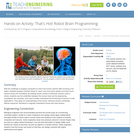
With the challenge to program computers to mimic the human reaction after touching a hot object, students program LEGO® robots to "react" and move back quickly once their touch sensors bump into something. By relating human senses to electronic sensors used in robots, students see the similarities between the human brain and its engineering counterpart, the computer, and come to better understand the functioning of sensors in both applications. They apply an understanding of the human "stimulus-sensor-coordinator-effector-response" framework to logically understand human and robot actions.
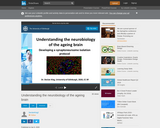
In this CC BY licensed PowerPoint presentation, Dr. Declan King, who is a post-doc in the Centre for Discovery Brain Sciences at the Edinburgh Medical School: Biomedical Sciences’ at the University of Edinburgh gives a brief explanation of the ageing brain and briefly describes a useful method for isolating both protein and RNA preparations from enriched synaptic fractions from post-mortem brain tissue.
The PowerPoint style lecture was made into an OER by Dr. King on April 2020 as part of the Digital Education module for the Postgraduate Certificate (PgCert) in Academic Practice at The University of Edinburgh.

Students learn about electric motors and rotational sensors. They learn that motors convert electrical energy to mechanical energy and typically include rotational sensors to enable distance measuring. They also learn the basics about gear trains and gear ratios. Students create a basic program using the LEGO MINDSTORMS(TM) NXT interface to control a motor to move a small robot. Then, through a 10-minute mini-activity, they make measurements and observations to test a LEGO rotation sensor's ability to measure distance in rotations. This prepares them for the associated activity during which they calculate how many wheel rotations are needed to travel a distance. A PowerPoint® presentation, worksheet and pre/post quizzes are provided.
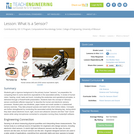
Students gain a rigorous background in the primary human "sensors," as preparation for comparing them to some electronic equivalents in the associated activity. A review of human vision, hearing, smell, taste and touch, including the anatomies and operational principles, is delivered through a PowerPoint® presentation. Students learn the concept of "stimulus-sensor-coordinator-effector-response" to describe the human and electronic sensory processes. Student pairs use blindfolds, paper towels and small candies in a taste/smell sensory exercise. They take pre/post quizzes and watch two short online videos. Concepts are further strengthened by conducting the associated activity the following day, during which they learn about electronic touch, light, sound and ultrasonic sensors and then "see" sound waves while using microphones connected to computers running (free) Audacity® software.

Students learn how neurons send and receive messages, and then build a model neuron. This activity is from the Brain Chemistry Teacher's Guide. Lessons in the guide are most appropriate for students in grades 5-10.